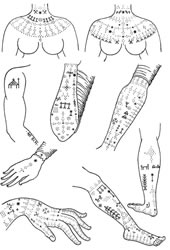India: Land of Eternal Ink
Article © 2009 Lars Krutak
Gujarat
Not surprisingly, several tribes in Gujarat
like the agrarian Mer believe that tattoos,
not prosperity or wealth, are the only
substantive things that accompany them into
the afterlife. A Mer proverb relates: "We
may be deprived of all things of this world,
but nobody has the power to remove the
tattoo marks." A Mer tattoo song also brings
out this idea more clearly:
Rama O Rama, my tattoos are of the colour of
"Hingalo [vermillion]," O Rama;
Listen, O Rama, uncle, brothers and
grand-father,
O Rama;
Mother and aunt and all return from the
gateway,
O Rama;
These tattoos are my companions to the
funeral
pyre, O Rama;
Rama O Rama, my tattoos are of the colour of
"Hingalo," O Rama.
The Dangs shared a similar belief stating,
"the marks would go with us to paradise but
if one is not tattooed, after death God will
use a red-hot ploughshare to make them."
The tattoo motifs preferred by the Mers have
a close relation to secular and religious
subjects of devotion. Designs include holy
men, feet of Rama or Lakshmi, women carrying
water in pitchers on their head, Shravana
carrying his parents on a lath (kāvad) to
centers of pilgrimage, and popular gods like
Rama, Krishna and Hanuman are also depicted.
The lion, tiger, horse, camel, peacock,
scorpion, bee and fly are other favorites.
Symbols derived from nature such as those of
the coconut, date palm, mango, and acacia
tree or champa flowers and almond nuts are
also common. Articles of daily use such as
pedestals, cradles, and even confections
occur (Figs. 26-31). Other tattoo subjects
such as shrines, thrones, wells, anchors,
chains, and groups of various agricultural
grains are found.
Mer men are not profusely tattooed and it is
customary for them to have marks placed
about their wrists, on the backs of their
hands, and sometimes on the right shoulder.
Camels are common symbols for the shoulder
and they are favorite motif, as they are for
the Rabari men of Gujarat who have them
tattooed on the back of the palm or on the
right shoulder. One authority has stated
that the placement of men's tattoos on the
right may relate to the importance of the
right hand in Hindu belief; "it is generally
associated with 'good omens' and used for
all forms of interaction with the natural
and supernatural worlds, such as eating,
writing, sacrificing, and for Brahmins,
tying the sacred cord." Other motifs common
among the men of both groups also include
Hindu inspired designs like Rama, Krishna,
or Hanuman or the om design in Hindu script
once again reflecting the process of
Hinduization among the once animistic tribal
peoples of Gujarat.
Mer girls were usually tattooed when they
were about seven or eight years old. The
hands and feet are marked first and then the
neck and breast. It is customary for a girl
to be tattooed before marriage; otherwise
her mother-in-law is likely to taunt her
that her parents are "mean or poor." One
tattooist of the Mer reported in the 1970s,
"if a bride were not tattooed, her in-laws
would protest that she had been sent to them
'like a man.'"
The indigenous instrument used in tattooing
is a reed stick having two or three needles
inserted at one end in such a way that only
about 1/4 of a centimeter of the points remain
visible. The needle points are dipped into a
prepared pigment of soot and cow's urine or
soot and the juice of the leaves of the
tulsi plant - sometimes water in which the
bark of biyān or sisam (Dalbergia lotifolia)
mixed with turmeric was used. The first type
of pigment provides a blue-black color while
the second produces a green hue. Red pigment
(mercury oxide) is also reported to have
been used by some. These pigments were
pricked into the stretched skin at least
seven or eight times to form the desired
tattoo.
A Mer woman's most favorite tattoo design is
called hānsali which encompasses the neck
and moves downwards towards the breasts. Its
name is derived from a silver necklace which
is thick in the middle and coiled at both
ends. More specifically, the hānsali begins
at the neck with a flower-motif in center
and with peacocks on either side. It is
followed below by the lādu ("sweet meat") or
bājoth (pedestal), on either side of which
occur rows of about four or five holy men.
These human figures are supposed to protect
the chastity of the women so tattooed. Next
follows two or three crescented rows, one
below the other, of enlarged deri (cover of
a churning pot) motifs with flower, bee,
etc. occurring at intervals. Likewise, the
motifs of four or five grains and pāniāri
(water pitchers) adorn the breasts
profusely. On the forearm, the tattoo starts
from the biceps and invariably has pāniāri
and peacock motifs followed by others. The
whole hand is ornamented with various
markings, the dotted designs occur
repeatedly while the linear ones appear
sparingly. On the back and sides of the palm
and the fingers two or three pairs of grain
motifs are marked. The three-grain motif
generally represents a diminutive form of
deri motif. The legs are tattooed up to the
knees, the front part of which is tattooed
more than the calf muscles. The linear
motifs like those of khajuri (date palm),
bāval tree, āmbo (mango tree), and deri
accompanied by tiger and lion adorn the
legs. The exquisite motif of the pāniāri
girdle around the border of the inner feet
is supposed to enhance the charm of the Mer
women.
The operation of tattooing is generally
executed by the experienced women of the Mer
tribe. The women of some wandering ethnic
groups like the Vāgharis and Nats also do
this work and tour the villages in the
winter. Traditionally, tattoo artists were
paid in grain, but by the 1950s all
transactions were made in cash and tattoos
were increasingly made by men with tattoo
machines.
The Rabari of the Kutch district on India's
northwest coast near the Pakistan border
also tattooed and continue to do so to this
day, although younger women who live in
urban areas are receiving fewer tattoos
because "We are now city people, and tattoos
are old-fashioned." Notwithstanding, for
hundreds of years the tribal women living in
this region have practiced tattooing for
decorative, religious, and therapeutic
purposes. Traditional patterns (trajuva)
were passed down and elder women worked as
the tattoo artists at fairs, festivals, and
markets when Rabari from the hinterlands
gathered to trade their goods and catch-up
with dispersed family members (Figs. 32, 33A
& 33B).
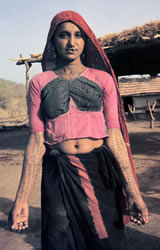 |
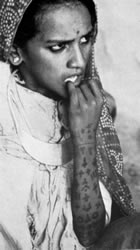 |
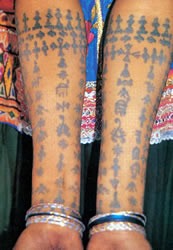 |
|
Fig. 32) Rabari body
tattoos |
Fig. 33A) Rabari
forearm markings |
Fig. 33B) Rabari arm
tattoos
Photograph © Michael Laukien |
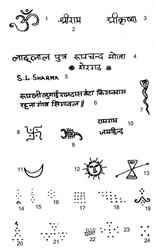 |
|
Fig. 34) Various
tattoo symbols |
Tattoo pigment was prepared by mixing
lampblack with tannin extracted from the
bark of the local kino tree, or with
mother's milk and sometimes urine. A
traditional Rabari tattoo kit is simple: a
single needle and gourd bowl to hold the
liquid pigment.
Nearly all surfaces of the body are
tattooed: face, neck, breasts, arms, hands,
legs, and feet. Some Kutch tattoos are caste
marks for their particular occupations
(e.g., herders, comb-makers, or traveling
blacksmiths) while others are thought to
induce fertility or attract a husband. Still
more, usually those motifs with counterparts
in nature (e.g., lioness, scorpion, spider),
render magical protection while others
relate to religious Hindu mythology (Fig.
34). Some women believe their tattoos are
extremely appealing to the opposite sex and
that men believe tattooed women are more
faithful. Many of the Rabari motifs parallel
those of the Mer in form and function.
Nagaland and Arunachal Pradesh
The Naga ethnic groups of northeast India
appear to have migrated to their present
location from Tibet sometime around A.D.
400. Naga settlements are situated amidst
mountains that slope forth into endless
successive saddles traversed by innumerable
rivers, streams, and rivulets. Formerly, all
groups were headhunters, and the Indian
government outlawed the practice in 1953;
but rumors persist to this day that men are
still on the human hunt in more remote
areas. Although most Naga tribes have
converted to Christianity, traditional
animistic religion continues to focus upon
unseen higher powers that regulate human
destinies.
One hundred years ago, tattooing was a
widespread custom reserved for women and
warrior men. Today, it is becoming
increasingly rare and its social meanings
lost. However, a large amount of detailed
ethnographic information on Naga tattooing
exists. Much of it was written in the
1920s-30s when the largely unsurveyed areas
of the Naga homelands were slowly opened up
to outsiders through the reports of intrepid
government agents, anthropologists, and
other travelers.
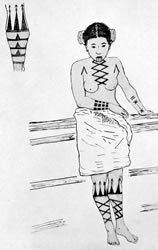 |
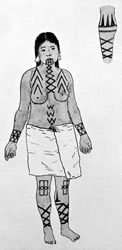 |
|
Fig. 35) Ao Naga body
tattooing
|
Fig. 36) Ao body
tattoos |
Among the Ao Naga, tattoo artists were
always old women who performed the rite in
the jungle near their village (Figs. 35 & 36).
Ao men were seldom tattooed, and it was
strictly forbidden in many villages for any
male to be present when a woman was being
marked; this rule was also followed for the
Wancho Naga of Arunachal Pradesh. The old
women with the necessary knowledge to tattoo
were only found in a comparatively few
villages, and they toured the country in
December and January. These months were
usually chosen for the operation on the
grounds that the colder it is the more
quickly the sores healed. The knowledge of
the art was hereditary in the female line,
the operators teaching it to their
daughters, who in turn taught it to their
daughters. In some villages, it was more or
less obligatory for a daughter of a
tattooist to follow her mother's profession.
It was believed that if she didn't, her life
would be filled with illness and she would
eventually waste away.
Girls were generally tattooed before
puberty, when they were from ten to fourteen
years old. Ao Naga informants interviewed in
the 1920s said that is was of the utmost
importance for a girl to be tattooed,
otherwise "she would be in disgrace and
would not marry well."
When a girl is about to be tattooed, a
bamboo mat is placed on the ground on which
she reclines. Several old women hold her
down while the operator plies her
instruments. The tool used for puncturing
the skin consists of a little bunch of cane
thorns bound on a wooden holder, which is
inserted into an adze-like head made from
the stalk of a plant. The pattern to be
tattooed is marked by the old woman on the
girl's skin with a piece of wood dipped in
the coloring matter. If a girl struggles and
screams during the tattooing, a fowl is
hastily sacrificed close-by to appease any
evil spirit that may be increasing the pain.
The puncturing is done by hammering this
instrument into the skin with a root of
kamri: a particularly heavy, sappy plant
with an onion shaped root. The black
coloring matter is then applied once more
after the blood has been washed off, and the
tattoo client is left to bemoan her sores
until they have healed. Usually the coloring
matter is made from the sap of the bark of a
tree called napthi. This is collected and
burnt in a pot on the fire. A leaf or a bit
of broken pottery is put over the receptacle
in which the sap is burning, and the soot
which accumulates is collected and mixed.
Among the headhunting Konyak, young boys
were ceremonially tattooed on reaching adult
age as a sign of manhood. Before the annual
ritual was performed, it was necessary for
the group of young men to capture at least
one head from an enemy's village. Magical
power was attached to the head and it was
believed to increase the fertility of the
crops and the men who took it. Like the
Wancho, the tattooing was usually performed
by the principal wife of the chief or ang of
the village, a woman of pure blood of the
aristocratic clan. To prick the pattern on
the face of one man took an entire day (Fig.
37). Those who could withstand the pain also
had the neck and chest tattooed (Fig. 38).
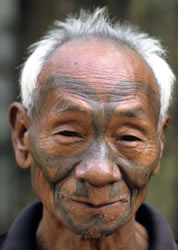 |
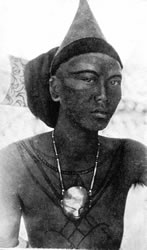 |
|
Fig. 37)Upper Konyak
facial tattooing |
Fig. 38) Son of the
Ang of Chui, Upper Konyak, ca. 1925. |
As a Konyak man matured, he was compelled to
continue his headhunting quests. When enemy
heads were captured, they were either cut up
into pieces or brought back whole to the
village gate. The eldest male members of
each clan then performed an important
ceremony. They took a fresh egg and smashed
it against the head; then they poured
rice-beer over the head saying in a low
voice: "May your mother come, may your
father come; may your brothers come; may all
come!" The destruction of the egg was
intended to blind - by sympathetic magic -
the victim's relatives so that in the future
they would be easier to kill. Finally, the
skull feeding ceremony was conducted. This
practice was believed to influence the soul
of the victim and to call all of his
relatives so that they too may be killed and
their heads brought to the village.
Afterwards the head was placed in a basket
and hung on an enormous log drum (khom) and
then rhythms were pounded out to notify
neighboring villages of the successful
headhunting campaign. Later in the evening
the head was brought to the morung or men's
house of the clan who captured it.
Even when headhunting was officially
outlawed in the 1950s, the Konyak and other
Naga groups did not give up their tattooing
customs. Instead, they substituted monkey
skulls, carved wooden heads or even wooden
dummies for their human victims and carried
them into the village shouting songs of
victory as if they had just taken a real
enemy. Then, the tattooing ritual was
performed. Today, however, it is quite rare
to see any Konyak or Wancho man under the
age of seventy with facial tattooing. It is
a dying cultural practice that will
disappear in the next generation.
Next Page
|
1
|
2
|
3
|
4
|
5
|

